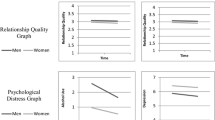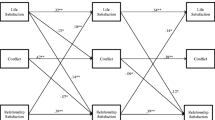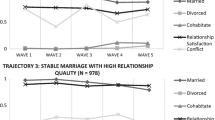Abstract
Gender differences were explored in the longitudinal association between relationship satisfaction and dysphoria in 145 dating college students attending a large public university. Of the participants, 80% were Caucasian, 14% were African American, 3% were Asian, and 3% represented other racial/ethnic groups. Based upon a previous longitudinal investigation (F. D. Fincham, S. R. H. Beach, G. T. Harold, & L. N. Osborne, 1997) and recent theoretical explanations for the gender difference in depression, it was hypothesized that initial relationship satisfaction would predict later dysphoria in women but not in men. Conversely, it was predicted that initial dysphoria would be predictive of later relationship satisfaction for men but not women. Hypotheses were tested using hierarchical multiple regression analyses in which initial levels of the predicted variables were controlled. Whereas results supported the first hypothesis, initial dysphoria was predictive of later relationship adjustment for both men and women.
Similar content being viewed by others
REFERENCES
Aiken, L. S., & West, S. G. (1991). Multiple regression: Testing and interpreting interactions. Newbury Park, CA: Sage.
Beach, S. R. H., Jouriles, E.N., & O'Leary, K.D. (1985). Extramarital sex: Impact on depression and commitment in couples seeking marital therapy. Journal of Sex and Marital Therapy, 11, 99-108.
Beach, S. R. H., Smith, D. A., & Fincham, F. D. (1994). Marital interventions for depression: Empirical foundation and future prospects. Applied & Preventive Psychology, 3, 233-250.
Beck, A. T., & Steer, R. A. (1987). Manual for the Beck Depression Inventory. San Antonio, TX: Psychological Corp.
Beck, A. T., Steer, R. A., & Garbin, M.G. (1988). Psychometric properties of the Beck Depression Inventory: Twenty-five years of evaluation. Clinical Psychology Review, 8, 77-100.
Boggiano, A. K., & Barrett, M. (1991). Gender differences in depression in college students. Sex Roles, 25, 595-605.
Bumberry, W., Oliver, J. M., & McClure, J. N. (1978). Validation of the Beck Depression Inventory in a university population using psychiatric estimates as the criterion. Journal of Consulting and Clinical Psychology, 46, 150-155.
Cohen, J. (1988). Statistical power analysis for the behavioral sciences (2nd ed.). Hillsdale, NJ: Erlbaum.
Coyne, J. C. (1976). Depression and the response of others. Journal of Abnormal Psychology, 85, 86-193.
Coyne, J. C. (1994). Self-reported distress: Analog or ersatz depression? Psychological Bulletin, 116, 29-45.
Coyne, J. C., Kessler, R. C., Tal, M., Turnbull, J., Wortman, C. B., & Greden, J. F. (1987). Living with a depressed person. Journal of Consulting and Clinical Psychology, 55, 347-352.
Fincham, F.D., Beach, S. R. H., Harold, G. T., & Osborne, L. N. (1997). Marital satisfaction and depression: Different causal relationships for men and women? Psychological Science, 8, 351-357.
Gotlib, I. H., & Beach, S. R. H. (1995). A marital/family discord model of depression: Implications for therapeutic intervention. In N. S. Jacobson, & A. S. Gurman (Eds.), Clinical handbook of couples therapy (pp. 411-435). New York: Guilford Press.
Gotlib, I. H., & Whiffen, V. E. (1989). Depression and marital functioning: An examination of specificity and gender differences. Journal of Abnormal Psychology, 98, 23-30.
Heim, S.C., & Snyder, D.K. (1991). Predicting depression from marital distress and attributional processes. Journal of Marital and Family Therapy, 17, 67-72.
Hendrick, S. S. (1988). A generic measure of relationship satisfaction. Journal of Marriage and the Family, 50, 93-98.
Jack, D. C. (1991). Silencing the self: Women and depression. Cambridge: Harvard University Press.
Jordan, J. V., Kaplan, A. J., Miller, J. B., Stiver, I. P., & Surrey, J. L. (1991). Women's growth in connecting: Writings from the Stone Center. New York, NY: Guilford Press.
Melchior, L. A., Huba, G. J., Brown, V. B., & Reback, C. J. (1993). A short depression index for women. Educational and Psychological Measurement, 53, 1117-1125.
Nolen-Hoeksema, S. (1987). Sex differences in unipolar depression: Evidence and theory. Psychological Bulletin, 101, 259-282.
Paykel, E. S. (1991). Depression in women. British Journal of Psychiatry, Supplement, 10, 22-29.
Radloff, L. S. (1977). The CES-D scale:Aself-report depression scale for research in the general population. Applied Psychological Measurement, 1, 385-401.
Robbins, P. R., & Tank, R. H. (1991). Gender differences in the attribution of causes for depressed feelings. Psychological Reports, 68, 1209-1210.
Rusbult, C. E. (1983). A longitudinal test of the investment model: The development (and deterioration) of satisfaction and commitment in heterosexual involvements. Journal of Personality and Social Psychology, 45, 101-117.
Segrin, C. (1999). Interpersonal communication problems associated with depression and loneliness. In P. A. Andersen & L. K. Guerrero (Eds.), Handbook of communication and emotion: Research, theory, applications, and contexts (pp. 215-242). San Diego: Academic Press.
Snyder, D. K., Mangrum, L. F., & Will, R. M. (1993). Predicting couples' responses to marital therapy:Acomparison of short and long-term predictors. Journal of Consulting and Clinical Psychology, 61, 61-69.
Thompson, J. M., Whiffen, V. E., & Blain, M. D. (1995). Depressive symptoms, sex and perceptions of intimate relationships. Journal of Social and Personal Relationships, 12, 49-66.
Weissman, M. M. (1987). Advances in psychiatric epidemiology: Rates and risks for major depression. American Journal of Public Health, 77, 445-451.
Whisman, M. A. (2001). The association between depression and marital dissatisfaction. In S. R. H. Beach (Ed.), Marital and family processes in depression: A scientific foundation for clinical practice (pp. 3-24). Washington, DC: American Psychological Association.
Whisman, M. A., & Bruce, M. L. (1999). Marital dissatisfaction and incidence of major depressive episode in a community sample. Journal of Abnormal Psychology, 108, 674-678.
Author information
Authors and Affiliations
Rights and permissions
About this article
Cite this article
Remen, A.L., Chambless, D.L. Predicting Dysphoria and Relationship Adjustment: Gender Differences in Their Longitudinal Relationship. Sex Roles 44, 45–60 (2001). https://doi.org/10.1023/A:1011085816484
Issue Date:
DOI: https://doi.org/10.1023/A:1011085816484




